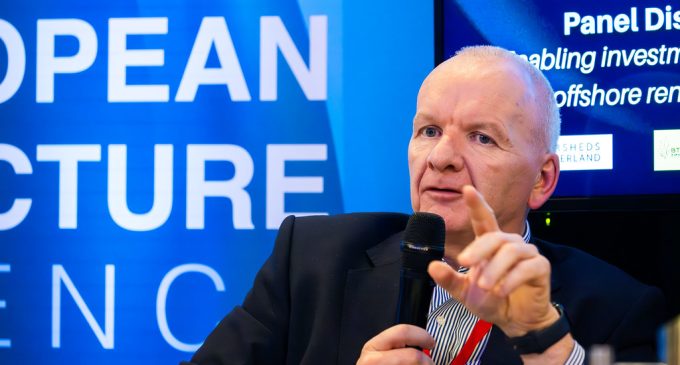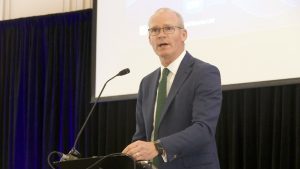Fixed transport links floated for Shannon Estuary

The Government of Ireland’s Response to the seminal Shannon Estuary Economic Taskforce Report suggests transport investments are ramping up in the Mid-West.
By David Keniry, January 2024
The Implementation Update published by the Department of Enterprise, Trade and Employment on 21 December states that initial responses from Departments and Agencies indicate that most recommended actions have been or will be implemented either as proposed by the Taskforce, or through existing or alternative measures which can achieve the same objective.
The seminal Taskforce Report launched last July at the Ardnacrusha Hydro Station provided a joined-up approach to infrastructure and economic development with actions on both national policy and region-specific initiatives. The Taskforce recommended that implementation updates be issued on a bi-annual basis.
Several region-specific initiatives have been accepted, including:
- A feasibility study for a national logistics hub in the Shannon Estuary;
- An undertaking from the Department of Transport that the mid-term review of the Regional Airports Programme will include a consideration of supports for Shannon Airport;
- The establishment of a Working Group to develop sustainable cruising at Foynes, following a Fáilte Ireland assessment of the feasibility and value of sustainable green cruise tourism;
- A commitment from Iarnród Éireann to assess the case for the provision of passenger rail services on the Limerick to Foynes rail line, including facilitating tourism/cruise ship related demand;
- The further development of greenways and segregated cycle routes around the Estuary.
This report and annex of actions published in December is the first such 6-monthly update with 89 actions as they relate to renewable energy, industry, transport, including the accelerated delivery of the Adare Bypass.
Notably, there is no mention of the largest infrastructure project planned for the region – the M20 Limerick to Cork scheme which featured in the Taskforce’s report and is a key element in Project Ireland 2040, the Government’s long-term overarching strategy.
Identification of the reduced road corridor, expanded active travel infrastructure, transport hubs, freight hub, enhanced public transport integration and environmental integration for the N/M20 Cork to Limerick project were published in a public update by the project team in November.
Limerick City and County Council in partnership with Cork County Council, Cork City Council, Transport Infrastructure Ireland (TII) and the Department of Transport are progressing Phase 3 Design and Environmental Evaluation. Further project updates will be published in Q2 (draft design) and Q4 2024 (final design and fence line), then seek government approval to submit the planning application.
Following a Parliamentary Question on accelerating the project, Minster for Transport Eamon Ryan confirmed that €5,000,000 has been allocated for the project in 2023 and the delivery programme for the project will be kept under review for 2024 and considered in terms of the overall funding envelope available to TII. The allocations for national roads for 2024 are expected to be announced in the coming weeks.
The N/M20 Cork to Limerick project is subject to the requirements of the Public Spending Code, and the next milestone under the code will be finalisation of the Preliminary Business Case at Decision Gate 1.
In March 2023, the Minister for Public Expenditure, National Development Plan Delivery and Reform Paschal Donohoe informed Government of changes to the capital appraisal guidelines as part of a package of significant actions aimed at enhancing delivery of the NDP. Circular 06/2023 outlined key changes to the Public Spending Code including an increase to thresholds for major projects and the requirements for major projects at different stages in the project lifecycle. Further to this, the Public Spending Code capital appraisal guidelines would be replaced and superseded with a set of Infrastructure Guidelines.
The Infrastructure Guidelines were published on 21 December by the Department of Public Expenditure, National Development Plan Delivery and Reform’s National Investment Office.
The National Investment Office have refreshed the requirements for capital projects in the Infrastructure Guidelines, reducing the number of approval stages and streamlining the requirements for major projects, while retaining the international best practice governance and oversight arrangements already in place. This is to ensure that vital infrastructure projects will be delivered on time and delivered in a manner that ensures value for money.
An accompanying document on Strategic Assessment and Preliminary Business Case states these recommendations reflect best practice in project development it is the responsibility of the Accounting Officer of the Department funding the project to ensure that these guidelines are adopted.
The document states that all projects –irrespective of scale or cost are subject to financial appraisal and there is little point in pursuing a worthy project if it cannot be paid for. Throughout the project lifecycle, Sponsoring Agencies pay careful attention to forecasting all costs of a proposal and taking account of the spectrum of potential risks which may impact viability and deliverability.’
It adds that ‘Public Private Partnerships are an alternative way of financing a project.’
‘A PPP has the potential to offer value for money and timely delivery of infrastructure when applied to projects of the right scale, risk and operational profile. For investment proposals with particular characteristics, Sponsoring Agencies may wish to explore the potential to progress the project as a public private partnership with the National Development Finance Agency (NDFA).
The NDFA is the financial advisor to state authorities, agencies, and departments. The NDFA’s advice should, in general, be sought out at an early stage on a) All PPP projects, and, b) all projects with a capital value exceeding €75 million.’
Partnerships and blending public and private finance were key recommendations in the Shannon Estuary Economic Taskforce Report. The Taskforce identified the need for significant investment in the region’s transport, connectivity, digital and other critical infrastructures as a matter of priority with ‘minimal’ investment in public infrastructure over the last decade.
The Taskforce noted several projects were planned for the region by the various transport bodies and identified the need for their coordinated and accelerated delivery to support the future economic development and population growth of the region, the State’s offshore wind targets of 37 GW by 2050 and to enhance the quality of life for the current workforce and population in the region.
‘Key road investments that are overdue include connecting the region’s capital, Ireland’s third largest city, to the second largest, Cork, by the M20 motorway, and to Europe by an improved N24 to Rosslare.’ The Taskforce adds that the prompt construction of the M20 motorway between Cork and Limerick, as well as the Adare and Listowel bypasses are required to credibly extend an Atlantic Green Digital Corridor along the entire west coast of Ireland.
There is also no direct reference in the Implementation Update to bypasses of Newcastle West and Abbeyfeale on the N21 to Tralee, and the completion of the full Limerick Northern Distributor Road in Limerick, which the Taskforce recommended to be reconsidered. However, in November Ryan told local press that he will be focusing on the delivery of public transport services in Limerick ahead of the completion of the Northern Distributor Road.
The Taskforce considered a rail connection to Shannon Airport, the re-instated freight rail link to Foynes (with future upgrade to passenger), and improvements to the Limerick to Waterford corridor as being vital for supporting the economic and demographic growth expected in the region, and strongly support the proposed suburban rail network in the Limerick Shannon Metropolitan Area Transport Strategy as a key piece of the wider region’s intermodal connectivity.
The Implementation Update does state that Local Authorities will continue to deliver on ‘key infrastructural projects aligned to the Department of Transport funding’.
‘Government has approved the accelerated delivery of the Adare Bypass. TII and LCC are endeavouring to ensure that it will be in place for the Ryder Cup 2027. The project is expected to cost approx. €150m to deliver. The bypass will be a 7km segment of the planned Limerick to Foynes Project connecting Limerick to the port of Foynes.’
The Taskforce supported Shannon Foynes Port Company plans to develop container import/export facilities at Foynes and plans for the deep-water port on Foynes Island. The Taskforce recommends financial and permitting supports (as per EU Green Deal policy) for the proposed developments at Foynes and Moneypoint to enable the efficient production of floating wind turbines at scale, with facilities completed by Q4 2028.
The Implementation Update states that the Department of Transport is facilitating port engagement and working to resolve barriers to the delivery of ORE port infrastructure through the National Offshore Wind Energy Taskforce, including exploring the availability of funding streams to support the delivery of ORE port projects. The revised National Ports Policy will not consider a sovereign debt model (or alternative funding mechanisms or debt models) for prescribed ports.
On the recommendation for a feasibility study for a Global Net Zero Transhipment Hub at a suitable location in the Shannon Estuary that will leverage the availability of maritime efuel, sheltered deep water, landbanks, and location of global maritime importance.
The Department of Transport advise that it is a matter for each commercial port to request funding for the commissioning of feasibility studies. This would not be led by the Department of Transport nor form part of the Review of the National Ports Policy. Shannon Foynes Port Company are supportive of a future study, the timeframe for which being dependent on the development of offshore wind farms and subsequent development of eFuel facilities in the Estuary.
Meanwhile on the development of an LNG terminal in the estuary, which was the genesis of why the Taskforce was established from the Programme for Government, the Government position Policy Statement on the Importation of Fracked Gas remains in place, which determines it would not be appropriate for the development of any LNG terminals in Ireland to be permitted or proceeded with.
Commenting on the Implementation Update, Minister Coveney said:
“On July 8th in Ardnacrusha at the launch of the Taskforce’s Final Report, I stron gly welcomed the future vision for the Shannon Estuary region put forward alongside an ambitious and comprehensive action plan. The vision of a new industrial revolution powered by an abundant supply of renewable energy offering transformative opportunities for balanced regional economic growth is wholly consistent with the government’s White Paper on Enterprise.
gly welcomed the future vision for the Shannon Estuary region put forward alongside an ambitious and comprehensive action plan. The vision of a new industrial revolution powered by an abundant supply of renewable energy offering transformative opportunities for balanced regional economic growth is wholly consistent with the government’s White Paper on Enterprise.
“Government has made important strides in turning this vision into a reality over the past 6 months, but the journey is just beginning. I’m acutely aware that the Taskforce will expect more of government and that we continue to see progress continuing and indeed accelerating over the course of 2024 as we develop our offshore wind ambitions further. My department will continue to work with colleagues right across government to deliver on this.”
The Taskforce Chairman, Barry O’Sullivan said:
“On behalf of the Taskforce, I welcome the first progress update in respect of recommendations made by the Shannon Estuary Economic Taskforce. The Taskforce’s major area of focus was in respect of the deployment at scale of offshore wind off the Shannon Estuary which can serve regional, national and European energy needs. This can be transformative for the economic and social fabric of the region. To deliver on this ambition, we advocated that major national policies needed to be put in place by Government to allow for the expedited deployment of offshore wind.
“While it is encouraging to see progress at the national policy level, the Taskforce strongly recommends that a greater level of ambition and speed is required right across Government in relation to offshore wind. This includes developing port infrastructure, expediting planning procedures and providing for a West Coast DMAP [Designated Maritime Area Plan]. In that respect, I warmly welcome Government’s commitment to assess the potential for accelerating the development of a West Coast DMAP. I look forward to tangible progress being made in forthcoming progress reports.”
Source of Main Image: Barry O’Sullivan speaking at the European Infrastructure Conference 2023 in Dublin.
Image in article: Minister Simon Coveney speaking at the Power & Energy Conference 2023








